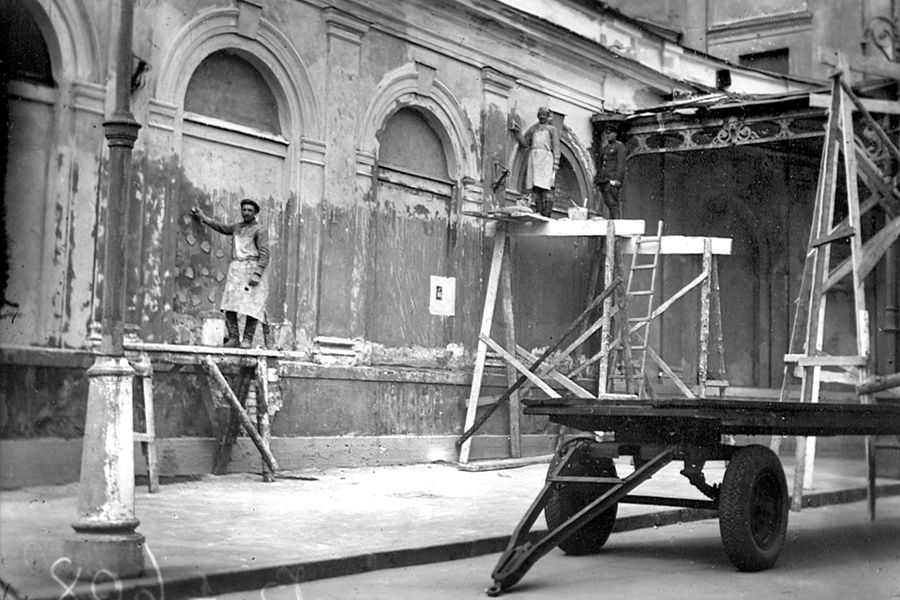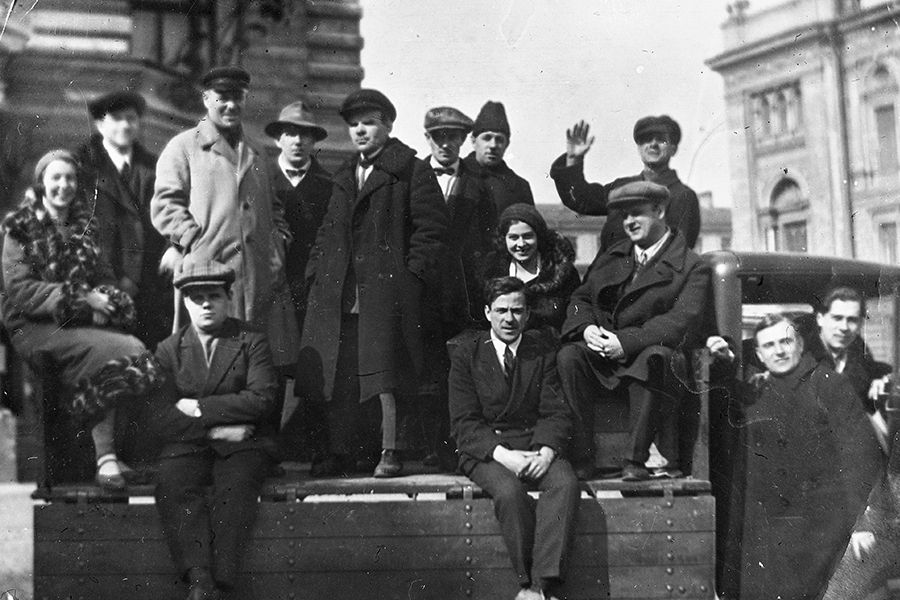

List of required building materials for the restoration of the theatre
“On 10 March the first two heated goods vans departed for Leningrad with one hundred and seventeen chests filled with the necessary costumes, dyes and materials that were no longer required by the theatre in Molotov. It was with these wagons that the designer Zandin, head of the production department Nikolai Ivantsov, designer S.F. Korsakov, decorator A.L. Maikov, head of the décor department A.I. Chulkov and the sick opera singer P.P. Gusev all set off for home.”*
* M. Frangopulo. The State Academic Kirov Opera and Ballet Theatre, Recipient of the Order of Lenin// Leningrad Theatres during World War II. Moscow-Leningrad; Iskusstvo, 1948. P. 91


Restoration of the theatre building. Winter-spring 1944
This is how the newspaper Leningrad Pravda described the state of the Kirov Theatre in early 1944: “The upper balconies have warped and sagged. The twelve-ton iron curtain is unusable. The emergency staircases and the pilaster gallery have collapsed. The lumps of falling rubble have smashed a hundred crystal chandeliers and almost all of the furniture in the elegant auditorium.
The stonemasons decided not to restore the gallery as they did not know the secret of the semi-circular cross-like inserts. At last two men were found – the carpenter Asyunkin and the mason Lobanov.”*
* Quote after M. Frangopulo. The State Academic Kirov Opera and Ballet Theatre, Recipient of the Order of Lenin// Leningrad Theatres during World War II. Moscow-Leningrad; Iskusstvo, 1948. P. 95


Galina Ulanova in Giselle
“The town of Molotov was also preparing for the theatre’s departure. At Giselle with Ulanova there were fears that the balcony and the gallery would collapse. So many people had come to see the very last performance. People were standing in the aisles, which was not previously permitted, and they absolutely wanted to catch forever the image of the great artiste they were losing.
“On 29 May we again stood on the platform of Molotov Railway Station at which our train from Leningrad had arrived almost three years ago. Only instead of heated goods wagons there were carriages with carpets on the floors, clean curtains hanging in the windows and bed linen that was white as snow. <...> On 2 June the first special train arrived. The second left on 5 June and the third on 9 June.”*
* M. Frangopulo. The State Academic Kirov Opera and Ballet Theatre, Recipient of the Order of Lenin// Leningrad Theatres during World War II. Moscow-Leningrad; Iskusstvo, 1948. P.P. 91-93

Galina Ulanova in Giselle
“The town of Molotov was also preparing for the theatre’s departure. At Giselle with Ulanova there were fears that the balcony and the gallery would collapse. So many people had come to see the very last performance. People were standing in the aisles, which was not previously permitted, and they absolutely wanted to catch forever the image of the great artiste they were losing.
“On 29 May we again stood on the platform of Molotov Railway Station at which our train from Leningrad had arrived almost three years ago. Only instead of heated goods wagons there were carriages with carpets on the floors, clean curtains hanging in the windows and bed linen that was white as snow. <...> On 2 June the first special train arrived. The second left on 5 June and the third on 9 June.”*
* M. Frangopulo. The State Academic Kirov Opera and Ballet Theatre, Recipient of the Order of Lenin// Leningrad Theatres during World War II. Moscow-Leningrad; Iskusstvo, 1948. P.P. 91-93

The return to Leningrad from evacuation. Georgy Nelepp, Feya Balabina, Konstantin Sergeyev, Natalia Dudinskaya, Vladimir Ponomarev and Nikolai Zubkovsky on the platform of the Moscow Railway Station. 1944
The performers met with a triumphant welcome from the victorious city. While in Molotov, many of the audience’s favourites had also received letters from theatre-goers, anxiously anticipating their return to their home theatre. Extract from a letter to Natalia Dudinskaya: “Believe me, my dear, that at the most difficult times I have never forgotten you or the theatre. The most important thing that has supported us and given us strength in this struggle has been the hope of being in that theatre once more, albeit on the 3rd balcony, to see Giselle or Laurencia. There is nothing more dear to me in life than the theatre and so I can never forget you. Will it come soon, that delicious moment that I hear of the theatre’s return home?”*
* Letter to N.M. Dudinskaya from I. Timofeyeva, an admirer of her art. 1942// Manuscript department of the Russian National Library. F. 1477 (N.M. Dudinskaya and K.M. Sergeyev), list 1, archive unit 32, sheets 1–1 reverse.





Photograph of repairs to the theatre
“In every corner of the theatre you could hear hammers, the walls were covered in scaffolding, and there was already a rehearsal of Susanin. On 25 August the theatre’s box-office opened. It was hard to get near to the building as there were so many people trying to get tickets. <...>
“There was still a smell of paint, you couldn’t touch the walls but the theatre was seething with life. In the dressing rooms there were insufficient chairs and tables, people were getting undressed at the windows and on window sills, wherever they could. The performers helped to wash the floors, doors and re-glazed windows.”*
* M. Frangopulo. The State Academic Kirov Opera and Ballet Theatre, Recipient of the Order of Lenin // Leningrad Theatres during World War II. Moscow-Leningrad; Iskusstvo, 1948. P. 94

Playbill for the opening of the 1944–1945 season
The opening was set for 1 September, but the first performance actually took place the day before. For the construction detachment of the border forces of the People’s Commissariat for Internal Affairs there was a performance of The Sleeping Beauty with Natalia Dudinskaya and Konstantin Sergeyev.

Natalia Dudinskaya in The Sleeping Beauty. 1940
Having been separated for three years, those who had been working in Molotov and those who had preserved their art in besieged Leningrad met at the theatre. Nonna Yastrebova, a 1941 graduate of the Leningrad School of Dance who during the siege had performed with the frontline ensemble based in Yukki near Leningrad, was demobilised and sent to work at the Kirov Theatre on the company’s return. She recalled that “I don’t know what was harder – to perform under gunfire, to dance on iced-over lorries or return to the profession after a gap of two and a half years. I removed my tarpaulin-material boots and military uniform... I had to put on my pointes and begin from scratch: standing at the barre and doing exercises, but my legs wouldn’t obey, the muscles were like wood, my body wouldn’t listen, my spine wouldn’t bend...
“Having been a pupil of Vaganova, at the theatre, too, I was in her perfection class. And there I felt like the ugly duckling surrounded by beautiful swans. It was incredibly difficult not just physically but morally as well. I had gone too far from my art and lost too much little by little. Standing at the barre, drenched in sweat and tears, in vain I tried to get back what I had lost. At times I felt bitterness, pain, resentment and fear. Was I to blame for the fact that there had been no opportunity for exercises? The cold, the hunger, the bombings, the constant relocations, the shelling. But the instances of weakness passed. Exposure on the frontline gave us a boost. I would tell myself ‘You must!’ I had to overcome the difficulties and not give up when faced with them, just as they never gave up on the frontlines. And, hardened by the experience of the frontline, I was able to overcome the most difficult obstacle I had ever faced in life – returning to my profession.”*
* N. Yastrebova// Soviet Ballet, 1985, No 2. P. 10



Concert ensemble of the Kirov Theatre on the island of Lavensaari. The quartet comprised Vladimir Yekimov, Mikhail Tsembarovich, Alexei Rastorguev and Yevgeny Wolf-Izrael. 3–15 July 1944
The performers who returned from Perm continued to travel for concerts for the Red Army and the Baltic Sea Fleet. One naval base was on the island of Lavensaari (Moshchny today) in the Gulf of Finland. From 1941–1944 it was the westernmost defence point from whence submarines from Kronstadt could dive deep and be met. The island of Gogland, forty kilometres to the west, was taken by the Germans.

Ballet dancer Yuri Monkovsky (born in 1919) says that “We arrived on Lavensaari on torpedo-boats. We gave concerts to great acclaim, but some time afterwards we learned that the sailors who are on duty on the Gulf on mine-sweepers were sorry that they could not see our performances. It was then that we decided to perform right there on the shore, on the jetty, on the moorings made from logs (you can imagine what that was like to dance on!). The boats came as close as possible to the shore and the crews watched our concert, standing on the decks. A plane circled in the sky due to the fact that having so many boats in one place was not without risk.”*
* Shorthand report of a talk with Yuri Monkovsky. 23 April 2015

Stage director Ilya Shlepyanov. Conductor Boris Khaikin. Photograph from 1945
1944 ended with a new production of La traviata (directed by Ilya Shlepyanov, conducted by Sergei Yeltsin and designed by Tatiana Bruni). And by May 1945 there was a new production of Eugene Onegin. The premiere was conducted by the theatre’s new Music Director Boris Khaikin.
The chronicle features photographs from the Mariinsky Theatre Archive, performers' family collections and the collection of the Central State Archive of Film and Photo Documents of St Petersburg.